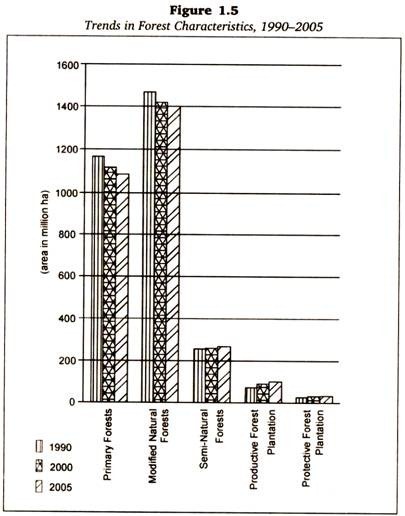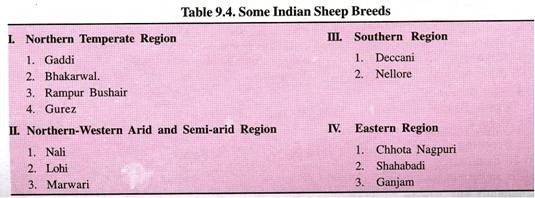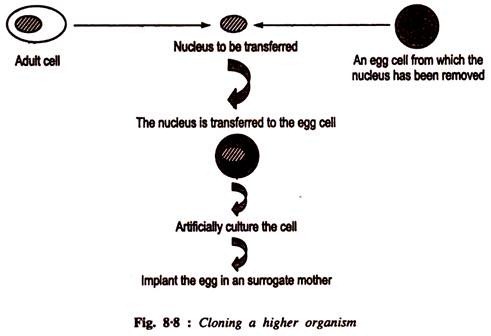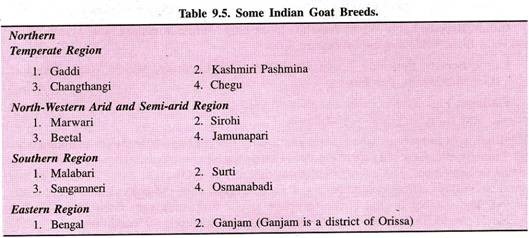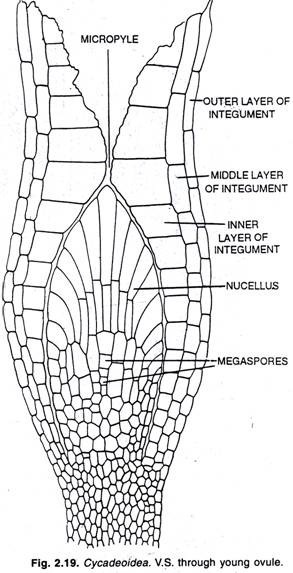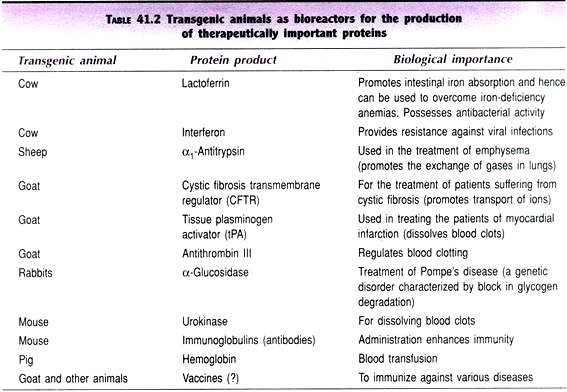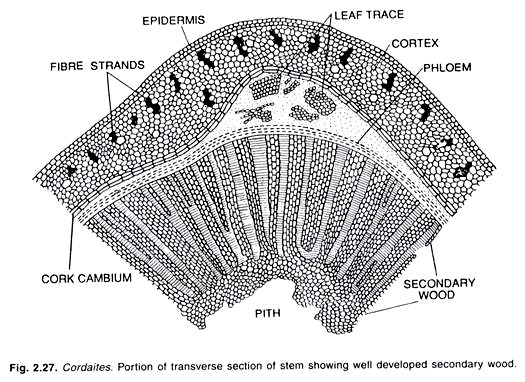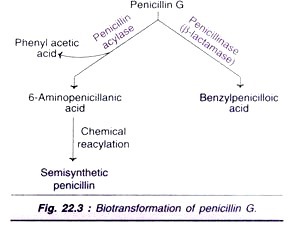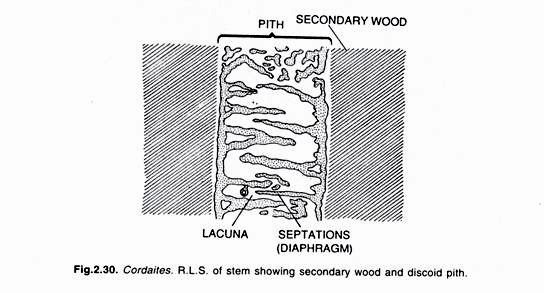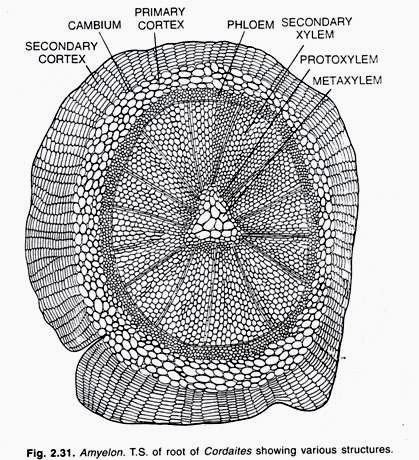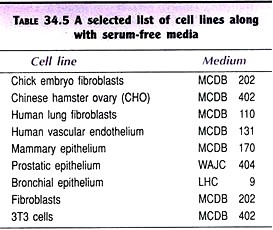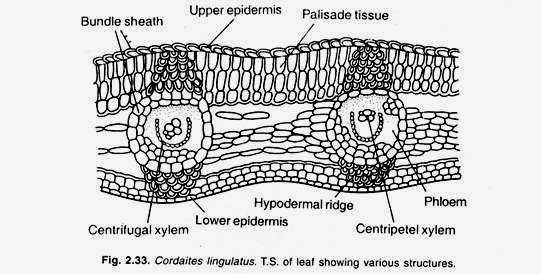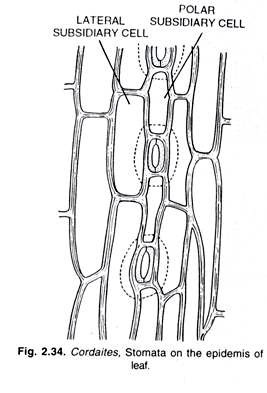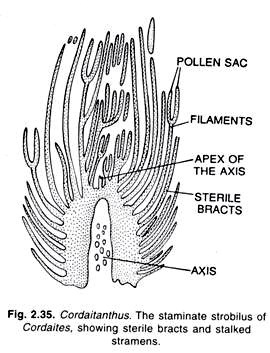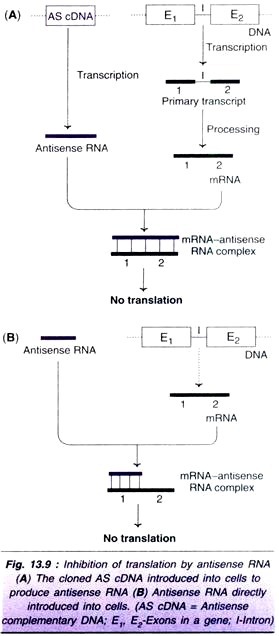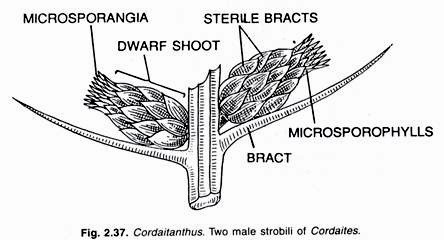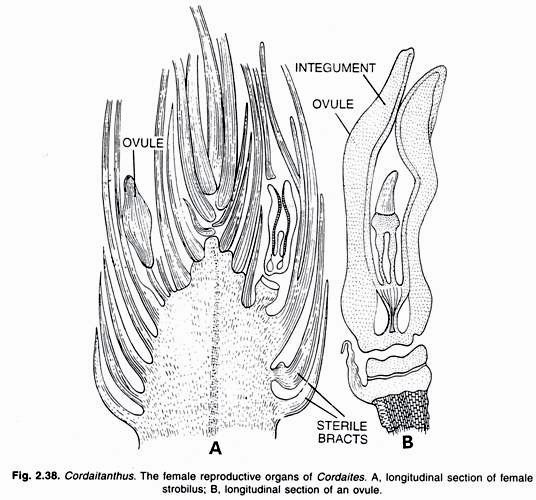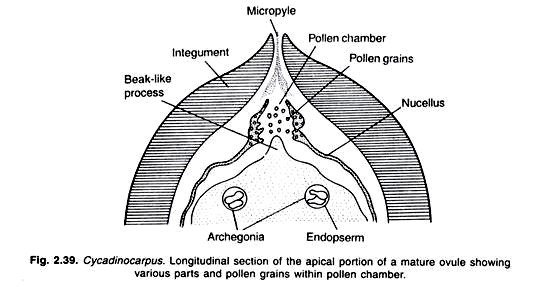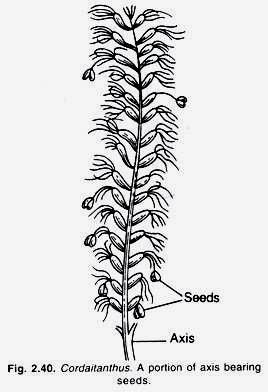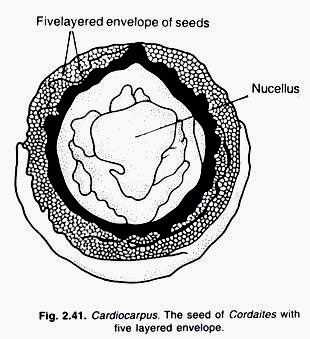The following points will highlight the two major causes of fossil gymnosperms. The classes are: (1) Cycadopsida and (2) Coniferopsida.
Contents
Fossil Gymnosperms: Class # 1.
Cycadopsida: Order-Pteridospermales (Cycadofilicales):
The Ptieridospermae or the Cycadofilicales are fossilized plants that first appeared in the upper Devonian. They were very common throughout the Carboniferous and extended upto Permian strata. After the Permian they began to decline and disappeared altogether.
It is in the early Devonian rocks that the members of some very primitive type of land plants disappeared. These plants were probably the simplest pteridophytes.
They had no roots, some without leaves and some had small tiny outgrowths which represented the leaves. This primitive group of land plants was different from pteridophytes. Their stem had well formed xylem and phloem tissue and the tips of the branches bore sporangia on them.
It is from the Upper Devonian through the Carboniferous and upto end to some extent into Permian strata also that we come across with a large number of fossilized plants belonging to Bryophytes, Pteridophytes and Gymnosperms.
The Carboniferous strata is very rich in plant remains. It appears that in those times the whole surface of earth was covered up by very extensive and luxurious forests. It seems that the climate in those times on the whole surface of earth was very uniform.
This view is based because identical fossils have been found in very widely separated areas. It appears that during this Carboniferous which is also described as coal age there were general and .sudden changes in the topography of earth.
It appears that very extensive forests got submerged and it is the submerged forests from which we get the extinct coal supply of present day. During this Carboniferous which has been sometimes described as age of ferns, very large sized Lycopods and Equisetales were common.
Along with these fossil pteridophytes, there were also present seeded plants which developed seeds of Cycadian type on them. Those plants which bore seeds were formerly described as Cycadofilicales. English workers (Oliver and Scott) described them as Pteridosperms while American workers call them Cycadofilicales.
These seeds were known to previous workers also but their association with fern like leaves was recognized in 1903. It was during this year that some of these Carboniferous seeds were found in organic continuity with the leaves of fern like plants. These seeded fossil plants have definite relation with gymnosperms of which American workers think they form an extinct class.
They show definite relationships with ferns on one side and cycads on the other.
They were distinctly spermous plants for their seeds were not enclosed in closed carpel as in angiosperms. This group of seeded plants was dominant during Carboniferous, they probably began in the Upper Devonian and began to decline in the Permian after which they disappeared altogether.
They were very widespread. They have been found in all countries in Northern Hemisphere and in Southern Hemisphere also they have been found wherever they have been searched for.
One of the best known plants is Lyginopteris which is best known of all Carboniferous plants. Before 1903 different parts of the plants were known, their stems, roots, leaves and also the seeds. On the whole surface of seeds capitate glands were present and it was the presence of these capitate glands that gave rise to idea that all these different parts of plants might be of one or same plant.
Later on the entire plant was found in one place in organic continuity from roots, stems and leaves.
A number of stem genera have been described from time to time. These stem, genera may be grouped under a number of families.
The more important families are Lyginopteridaceae, Medullosaceae, Calamopityaceae, Peltaspermaceae and Corystospermaceae.
Pant (1957) makes a distinct class Pteridospermopsida for these plants. He divided this into six orders.
These orders are -Lyginopteridales, Medullosales, Glossopteridales, Peltaspermales, Corystopermales and Caytoniales.
Genus: Lyginopteris (Calymatotheca)
Systematic Position:
Gymnosperms
Class: Cycadopsida
Order: Pteridospermales
Family: Lyginopteridaceae
Genus: Lyginopteris (Calymatotheca)
The genus Lyginopteris also known as Lyginodendron.
Morphological Features:
The stem Lyginopteris was slender and covered with large scaly leaves. Near the base of the plant adventitious roots developed. The plant seems to have been a climber.
Lyginopteris oldhamia also known as Calymatotheca hoeninghausi was described in detail by Williamson, Scott, Brongniart, Binney, Potonie, and Oliver and Scott. It was found abundantly in the coal ball horizon of Lancashire and Yorkshire.
Anatomical Features:
The Primary structure was an ectophloic siphonostele with large pith round a number of primary mesarch bundles. Older plants showed normal secondary growth. In some specimens, however, the xylem portion of primary vascular bundles was in a continuous ring. In some there was an abnormal type of secondary growth.
This abnormality was of two forms, either there was an inner ring of secondary phloem developed or it was that the cambium appeared in strips found separately in vascular bundles giving rise to a polystelic appearance.
Reproductive Structure:
Some of these Palaeozoic leaves bore microsporangia on them. The fertile pinnules were more or less peltate in form and on their underside they bore usually six sporangia. These sporangia are usually bilocular. Such a type has been described as Crossotheca type.
The microspores seem to have formed a male prothallus. The sperms seem to have been of like those of present-day cycads.
Seed:
The best known seed has been described under the name Lagenostoma. These seeds were small in size, only about 1/4 but they were highly organized. It was barrel shaped and whole seed enclosed in cupule. This cupule opened out when seed was mature.
Each seed was borne at the tip of stalk. The cupule rose from the base of the seed but not fused with it. The cupule was in three main lobes. These lobes were divided in the upper parts of the seeds. The seed or ovule was orthrotropus and of cycadian type. It was radially symmetrical.
The cupule was separated from the seed along its entire length. The seed itself has an integument which surrounded the nucellus. The integument and nucellus were fused except at the top. The integument formed nine projections. In each of these projections there was a vascular bundle present. These projections surrounded the nucellar beak.
The pollen grains then came to lie in pollen chamber formed by disorganization of some of nucellar tissue round the base of nucellar beak.
In some of preparations the megaspore membrane is very well seen. In the centre of the seed there was a tissue but so far neither any archegonium nor any embryo has been found in these Palaeozoic seeds.
The seeds were borne at the tips of the stalks. They were not organized to form cover. In addition to this Lagenostoma there are many other Palaeozoic seeds which have been described some simpler other more complex than Lagenostoma.
A peculiar feature of all Palaeozoic seeds which so for has not been explained is the absence of any embryo in them. Pollen grains have been found in pollen chambers. Some of them had even showed their germ tube, but so far no seed is discovered in which embryo was developed. It is possible that all the seeds described might have not preserved or they preserved before embryo formation.
Phylogenetic Relationships:
We find that the xylem in the case of pteridophytes show only scalariform thickening on it. In Cycads we find the pitted type of thickening on it. It is seen that the xylem of some cycads passes through scalariform stage and one recent cycad Stangeria, here the xylem shows only scalariform thickening in tracheids.
There were no pits. On account of the absence of pitted thickening the genus Stangeria was for a long time included among ferns, and it was only later when a plant was found bearing seeds on it that it was shifted from ferns to Cycadales.
The stem of Cycadofilicales has combined structure of both ferns and cycads. In Cycadofilicales arranged from protostelic to polystelic structure and there is found only in some of lower types like Marattia, Angiopteris, Ophioglossum and Botrychium. These Cycadofilicales in appearance were like the ferns. In Carboniferous times the vegetation was very much like most of present day ferns.
It was due to the strong resemblance in the external features that the group was described as Cycadofilicales. It was later on when seeds of Lagenostoma were found growing on leaves Lyginopteris that fern connection of the group came to an end.
English workers (Oliver and Scott) call the group Pteridosperms. They are of opinion that they belong to an extinct group of pteridophytes which has developed seeds on them. American workers called the group as Cycadofilicales. They think that the group has distinct affinities with ferns on one hand and Cycadales on other hand also.
The fossil leaves found in Carboniferous strata cannot be suitably assigned either to the ferns or to Cycadofilicales. With more advancing knowledge more and more of these Corboniferous leaves are coming to be associated with Cycadofilicales, and some workers have even gone so far to say that during the Carboniferous the ferns were not at all common and they did not exist in those times.
Some of the more primitive type of ferns probably did exist in those times but so far known all those types were homosporous. Heterospory probably developed only in Cycadofilicales.
These Cycadofilicales are of course definitely related to ferns in the general appearance of plant, the form of leaves, the general anatomy of stem and particularly in the form of microsporangia which in the two groups are very much alike the features which separate the Cycadofilicales from the ferns in a more complex stem anatomy with secondary growth and the presence of seed structure.
The origin of this seed structure has not been explained so far. There is no direct evidence with regard to the evolution of structure. There is only guess work, this seed habit must have preceded heterospory. It must have from some heterosporous plants that the Cycadofilicales had originated.
We know all bryophytes and primitive ferns are homosporous. It is only a few types of present day pteridophytes like Selaginella and heterosporous ferns that heterospory is seen, it appears that the two groups pteridophytes and Cycadofilicales have originated from some common ancestral group in which heterospory had come into existence or it may be that homosporous ancestral ferns may have given rise to pteridophytes and the heterosporous one to the Cycadofilicales.
So clearly the Cycadofilicales must have come from some heterosporous ancestors, but so far no such fossil has been discovered. Chamberlain and other American workers are of opinion that Cycadofilicales form the most primitive group of gymnosperms. Though there were no cones yet we know that in Cycas itself in the female there are no cones.
The seeds were like those of present day cycads, and like them the xylem had pitted thickenings on its wall.
English workers, however, think that the group is an extinct one and it is co-ordinate with gymnosperms and angiosperms and they call it Pteridosperms. They think, commonly met within the stem of Cycas the primary structure was polystelic. Each stem has secondary growth round it.
Fossil Gymnosperms: Class # 2.
Cycadopsida: Order-Cycadeoideales (Bennettitales):
Introduction:
The Cycadofilicales, they formed the dominant fossil plants during Palaeozoic age. The Cycadofilicales have of course definite affinities with the cycads on one side and ferns on the other, but they had no cones either in the male or in the female part of the plants, so some workers think that the Cycadofilicales form a separate group quite distinct from gymnosperms.
In the Mesozoic times, however, we came across fossils plants which had cones and were definitely related to gymnosperms. So in Mesozoic the Cycadofilicales were replaced by true gymnosperms which formed strobili, and the seeds had a naked dicotyledonous embryo in them. The ovule or the seed was never enclosed in closed carpel.
The Mesozoic gymnosperms can be placed into two separate groups:
1. Cycadeoidale (Bennettitales) and
2. Cycadales.
Pant (1957) has placed the cycadeiods in a distinct class, the Cycadeoideopsida of the division Cycadophyta.
The Cycadeoideales (Bennettitales) first appeared in the Permian they reached their highest range during the Jurassic period, after which they disappeared altogether.
The second group Cycadales had a world-wide distribution during the Mesozoic period Majority of them had altogether disappeared; only a few types have been left which are confined to special parts of the East. The present day cycads are only the remnants of very large dyeing out group, i.e., they are sometimes described as living fossils, because they are on their way to extinction.
The Cycadeoideales (Bennettitales) were very much like the cycads in their general appearance, and as the Mesozoic had these two prominent groups of gymnosperms, so that period sometimes described as age of cycads.
These Cycadeoideales are closely related to the Cycadofilicales on one side and to cycads on the other but they have their own characteristic features which distinguish them from all other gymnosperms except the Gnetales. The important feature which separates the Cycadeoideales from other gymnosperms is the presence of bisporangiate strobili.
The plants of this group were diversified in their habit. Some types had short columnar stems like most of the living cycads. The short columnar stem was usually un-branched and at the apex of the plant there was a terminal crown of leaves which in most cases pinnate.
Some other forms had branched stems with multiple crown. In present day cycads we know that young leaves and megasporophylls are covered up by unicellular hairy outgrowths known as ramenta.
In Cycadeoideales (Bennettitales) these ramenta were not unicellular; they were scale like, flattened and were several cells in breadth. Like cycads the plants had well organized strobili or cones, but in cycads they are monosporangiate whereas in Cycadeoideales they were usually bisporangiate and they were either terminal or axiarlly in position.
Majority of Cycadeoideales (Bennettitales) seem to have flowered only once in their life and after flowering the plant died out as we find in some of present day angiosperms.
Classification:
According to Sporne (1965), the order Cycadeoideales (Bennettitales) has been divided into three families.
They are:
1. Cycadeoideaceae
2. Williamsoniaceae
3. Wielandiellaceae
Here Cycadeoidea (Bennettites) of Cycadeoideaceae and Williamsonia of Williamsoinaceae have been discussed.
Genus: Cycadeoidea (Bennettites)
Systematic Position:
Gymnosperms
Class: Cycadopsida
Order: Cycadeoideales
Family: Cycadeoideaceae
Genus: Cycadeoidea
Bennettites, by American workers have been described as Cycadeoidea.
Morphological Features:
In Cycadeoidea the stem was un-branched with a single crown of pinnate leaves at the tops, but some species had branched stem with a multiple crown. In some the stem was tuberous. In all cases the stem was covered up by persistent leaf bases as we find in Cycas.
Anatomical Features:
In structure the stem usually had large pith and thin vascular cylinder in which the protoxylem was endarch, thick cortex with a number of gum canals in it. There was small amount of secondary growth. Growth rings were only in few cases where the cambium persisted and was more active, so on the whole the stem anatomy was like those of present day cycads i.e., with large pith, broad cortex and narrow vascular cylinder.
In some few cases, however, the vascular cylinder was sufficiently broad. In the stem there were no traces of mesarch vascular bundles which is a common feature of leaf traces of present day cycads.
Another distinction from cycads was that the leaf traces were direct and no girdles while in present day cycads the girdling of leaf traces is quite common. The xylem had scalariform thickenings; pitted thickenings rather rare.
This is an unusual feature because in the xylem of Cycadofilicales pitted thickening was very common and the group is much older than Cycadeoideales (Bennettitales). The feature can only be explained that it was case of reversion.
Leaves:
The leaves in Cycadeoidea (Bennettites) were large pinnate and showed xerophytic features. The vascular bundles in petiole and leaflets were mesarch with a strong sheath of sclerenchyma around it. Bipinnate leaves were rarely found in Cycadeoidea so the form and structure of leaf is practically like that of living cycads.
Fructifications:
The fructification in Cycadeoidea was bisporangiate. The strobili were developed in the upper part of the plant in large numbers. In some cases each leaf seems to have an axillary strobilus.
The whole of the strobilus and the bases of leaves were covered up by large sized scales which were several cells in breadth and sometimes more than one cell in thickness; strobili so were axillary and borne at the tip of axillary stalk or peduncle and therefore, these strobili can be described as dwarf branches.
Each strobilus was made up of a number of heavy imbricate reduced leaves or bracts. These bracts completely surrounded the strobilus when it was the earliest stage of development where the strobilus developed these imbricate bracts separated and the inner part of the strobilus exposed.
The second whorl was made up of a number of leaf like microsporophylls, all of which were united at the base to form a cup-shaped structure round the central part of strobilus. The third central portion was hemispherical or domeshaped in appearance. The central part was made up of a number of ovulate sporophylls. These megasporophylls were simply stalked.
At the tip of the stalk was developed an ovule. Some stalks were sterile and the tips of sterile stalks were flattened. The central stalks stood up vertically upward and they were longer in length.
The lateral ones continue to decrease in size from above downwards and stood projecting from lateral side, so the ripe female portion of strobilus hemispherical or dome-shaped in appearance. It is clear that in this bisporangiate strobilus the stamens or microsporophylls ripe first at which time the ovules were immature.
When the ovules matured the stamens were shed, so in the strobilus in which the ovules were ripe the microsporophylls were absent but in young strobilus both were present.
The microsporophylls or the stamens were 10 or 20 in number. These microsporophylls or stamens were all united at the base and each stamen was pinnate in form and on each stamen there were about twenty slender pinnae on either side, under the pinnae were developed two rows of fused sporangia or synangium had a short stalk and two pollen sacs in it; so each stamen was pinnate in form and was very much like the Marattious ferns in which we know the sporangia fuse to form synangia.
When stamens were very young they rolled downwards; so on the whole we can say that the stamens of Cycadeoidea (Bennettites) were very much like those of ferns, while in living gymnosperms they have lost their resemblance with the ordinary ferns.
The central portion was dome-shaped in form and this part was made up of a number of slender stalks, the central ones were long and stood vertically upwards, the lateral ones short and they diverged outwards. On the whole the female part was oblong in shape. Some of the stalks bore ovules while the others were sterile and their tips were expanded.
The male and female parts of strobilus were separated by the presence of some sterile bracts or scales. The ovule was orthrotropous and terminal. It was small in size and was surrounded by three-layered testa like that of Cycas. The nucellus was spearate from integuments only in the upper part the integument projects forward to form a long micropyle.
At the base of the micropyle the nucellus projected to form nucellus beak and round the base of nucellus beak there was a depression, the pollen chamber.
On the outside of the ovule there was a small basal cup which suggests the cupule of Lagenostoma, but it was much reduced in size and never surrounded the whole of ovule or seed at any time.
The ovule seems to fertilize by swimming sperms. After fertilization the ovule developed into a dicotyledonous embryo which was non-endospermic. When the seeds were developed the whole of the female part of strobilus became fleshy and formed a fruit.
In ripe fruit holes were present on the surface and at the base of these holes was dicot embryo while the fleshy portion of fruit was formed by stalk and interspersed sterile scales.
During the development of seed it appears that there was no suspensor developed. It might have been developed in the earlier stages of development of seed, but it is doubtful, so Cycadeoideales (Bennettitales) differ from other gymnosperms in these two important respects: 1. The non-formation of suspensor and 2. The presence of a non-albuminous dicot embryo.
Genus: Williamsonia (Williamsonia sewardiana Sahni)
Systematic Position:
Gymnosperms
Class: Cycadopsida
Order: Cycadeoideales
Family: Williamsoniaceae
Genus: Williamsonia
The second type of Cycadeoideales (Bennettitales) is known as Williamsonias cycads. This group of plants was more ancient than Cycadeoidea (Bennettites). The group differs both from Cycadeoidea and cycads in some important features, in the stem anatomy and also in the form and structure of fructification.
An Indian type Williamsonia sewardiana Sahni has been described from the Jurrasic period. It was found in a silicified condition in Rajmahal Hills (Bihar) which is made up of upper Gondwana rocks.
The stem was erect; cylindrical and branched. The branches were covered up by scales and also the leaf bases.
The stem anatomy of this type was more like those of conifers. The pith, however, was large, dense compact mass of xylem and phloem and the cortex was comparatively narrow.
The strobili were borne on short branched lateral shoots. They differ from those of Cycadeoidea in that they were monosporangiate. In this Williamsonia sewardiana only the female has so far been described but Dr. Sahni himself was of opinion that this Indian form might have been bisporangiate.
The specimen got separated from the strobilus. The structure of female portion was practically like that of Cycadeoidea (Bennettites).The ovules were borne on short stalks which had interstaminal scales in between. The ovule structure was again that of Cycadeoidea (Bennettites).
The male strobilus rather which has been described in some other species bf Willianisonia had a number of stamens which fused together to form a cup or discshaped structure. The free parts of stamens had two rows of slender leaflets were absent and only stalks were present.
So either on leaflets or on stalks there were two rows of pollen sacs. This way, the male portion of Williamsonia was like that of Cycadeoidea. A large number of male strobili have been described, but no trace of female portion in them has been found, so these male strobili were evidently unisexual while the female ones might have been bisexual.
Genus: Williamsoniella (Williamsoniella Angustifolia)
In other genus Williamsoniella, the strobilus was bisexual but round and there were no basal bracts, so it differed from Cycadeoidea only in the absence of bracts.
Affinities:
In many respects the Cycadeoideales resemble the ferns on one hand and the cycads on the other.
They resemble the ferns in the presence of a crown of leaves, persistent leaf bases, mesarch nature of vascular bundles direct course of leaf-traces through the cortical region. In Cycadeoidea the presence of synangium is much like that of ferns in which we know the sporangia are fused to form synangia.
The Cycadeoideales are closely related to Pteridosperinales on one hand and to cycads on the other but they have their own characteristic features which distinguish them from all other gymnosperms except the Gnetales; this important feature that separates the Cycadeoideales from other Gymnosperms is the presence of bisporangiate strobili.
Some types of this group had short columnar stems like most of the living cycads. The short columnar stem was usually un-branched and at the apex of the plant there was a terminal crown of leaves. In present day cycads the young leaves and megasporophylls remain covered up by unicellular ramenta whereas in Cycadeoideales these ramenta were scale-like. Like cycads the plants had well organized strobili or cones.
Majority of Cycadeoideales seem to have flowered only once in their life and after flowering the plant died out as we find in some of present angiosperms.
2. Class-Coniferopsida: Order-Cordaitales:
The Cordaitales is another fossil group which lived side by side with the Cycadofilicales in Palaeozoic times. Both the groups were very common, the Cordaitales being then the prevailing gymnospermous forest plants. The group extends from Devonian through Carboniferous upto the Permian times, and in India they had been found even in the lower Mesozoic, i.e., in Lower Gondwana strata of India.
The plants of this group were trees some even more than ninety feet in height and three feet in diameter. The plant branched at only tips and bore generally narrow and simple leaves in clusters at top.
According to Scott, the order may be divided into three groups:
1. Poroxyleae
2. Pityeae
3. Cordaiteae
The details, especially of first two groups are not fully known. Their separation from Cordaiteae is based on structure of vegetative parts.
1. Poroxyleae:
This had a single genus known as Poroxylon. Here the stem was slender with long internodes and within the stem were collateral exarch primary bundles, the pith was large, and double leaf traces for each leaf which had thick parallel venation in it.
2. Pityeae:
It included a single genus Pitys where the bundles were mesarch, the wood was with multiciliated pits, so it differed from Cordaiteae having mesarch bundles.
3. Cordaiteae:
It included a number of genera. The best known genus was Cordaites.
Genus: Cordaites:
Systematic Position:
Division: Gymnospermae
Class: Coniferopsida
Order: Cordaitales
Family: Cordaitaceae
Genus: Cordaites
Morphological Features:
The plant was tall and slender. It had a crown of branches near the top, leaves were large simple and pendulate and not found in any living gymnosperms.
Anatomical Features:
The internal structure of stem in Cordaites showed a combination of Cycas and conifers characters. Pith like cycads layer but discoid in form, i.e., it was in form of plates at intervals. The vascular cylinder was like those of conifers. It was made up of thick collateral endarch primary bundles which sometimes however, seem to have been mesarch as in Mesoxylon.
There was good deal of normal secondary growth. Secondary xylem was made up of living pitted tracheids with pits on radial walls. In fact it is clear that majority of plants found in Carboniferous period belonging to Cycadofllicales, Cordaitales and a number of fossil pteridophytes. The stems had good deal of secondary growth in them, but in these no annular rings.
The stem anatomy of Cordaitales shows variations from exarch to endarch collateral primary vascular bundles with good deal of secondary growth in stem. So far anatomical structure is concerned the group is related to Cycadofilicales in having exarch and mesarch bundles and to gymnosperms especially to conifers in having developed endarch bundles.
Reproductive Structures:
The plants were monoecious or dioecious but the strobili were always monosporous and never bisporangiate like Cycadeoideales (Bennettitales) or living Gnetales. Cordaitanthus was the reproductive shoot of Cordaites itself It was not definitely organized to form a cone but it was more or less a strobilus.
The male and female strobili were borne separately in lateral sides of short simple axis. The strobili were enclosed when young by bracts so outwardly they could not be distinguished unless sections were cut and examined. Both were usually of small size.
Male Strobilus:
The male strobilus had a thick axis bearing spirally arranged bracts with stamens on them, the stamens themselves were either solitary or grouped near the apex and in between the stamens there were sterile bracts present. These bracts might have been sterile microsporophylls.
Each individual stamen was peculiar in form, in that it had a cluster of three to six terminal sporangia similar types of stamens have also sometimes described belonging to Cycadofilicales, but the important difference was that at the tips were borne synangia and separate or individual sporangia.
If in this male catkin of Cordaites there were no sterile bracts the structure would be very much like the staminate strobilus of Ginkgo but there is a very important difference and that in the Cordaitanthus the sporangia were terminal while in Ginkgo they were pendant and only two in number.
In fact the morphology of this male strobilus of Cordaites is not quite clear. Different interpretations are put on male catkin of Cordaites. Some think that whole of strobilus acting as single male flower in which there are large number of stamens, the stalk being the filamentous bearing a number of pollen sacs were simply sterile filaments.
Other workers described this male catkin as inflorescence, each catkin bearing a flower itself, the filament is stalk of flower, the pollen sacs the stamens.
Female Strobilus:
The female strobilus when young was enclosed by bracts. It had a thick conical axis bearing a number of spirally arranged bracts. In the axils of some of these bracts there were dwarf shoots present. These dwarf shoots in turn had minute bracts. On the tip of dwarf shoot there was a terminal ovule.
The Ovule:
In the ovule the nucellus was completely separate from the integument. The integument formed a micropyle; at the base of micropyle the nucellus formed a prominent nucellar beak and a large pollen chamber. Round the ovules there were two coats outer thick and fleshy and the inner one delicate in young ovule but hard in older ovules. Both these coats were separate below but more or less united above.
So these coats may be interpreted as two separate integuments which are formed at upper part or a case of single integument which differentiated into three coats one of which not preserved.
The female strobilus is distinctly compound in form as compared to male strobilus. The ovule bearing stalks were distinctly axillary in position just like those of present day conifers.
In Cycadofilicales, Cycadeoideales (Bennettitales) and the living cycads the ovule bearing structures are not axillary in position and the ovules in these groups were borne on leaves while in Cordaitales and the Coniferales the ovules are borne on stem structure. Dr. Sahni according to the position of ovules recognized two groups.
1. Phyllosperms and
2. Stachysperms
1. Phyllosperms:
The ovules borne on leaves as seen in pteridosperms and Cycas.
2. Stachysperms:
The ovules as seen in Cordaitales, Ginkgo and the Coniferales.
A large number of detached seeds have been described from Palaeozoic times and when they separated from branches they cannot definitely be assigned to Cycadofilicales and to Cordaitales. Generally according to Dr. Sahni those belonging to Cordaitales were flat and described as platy-sperms and more or less heart shaped in appearance and no embryo in them like those of Cycadofilicales.
Affinities:
Cordaitales and Cycadofilicales lived side by side in Palaeozoic time, both were very abundant in Carboniferous and disappeared just about Permian. Backwards both groups extend to Devonian, which of two is more ancient cannot be definitely stated.
Both seem to be related is clear from their habitat, the general form and structure of plants, the form of strobili especially male one, structure and form of ovule and finally of seed was very primitive in the two in the ovule of the two the presence of free nucellus.
The form of integument with two sets of vascular bundles in it, and the form of pollen chamber and lastly the absence of embryo are really primitive features which naturally present in the primitive groups. All these resemblances mean that either the Cycadofilicales give rise to Cordaitales or the Cordaitales to Cycadofilicales.
All combined features show that Cycadofilicales are more primitive while the Cordaitales show advanced features.
The other possibility is that both of them might have arisen from some common ancestral form as they lived side by side. So this second possibility is more accepted but what the ancestral form is not known.
Evidently it must be some heterosporous pteridophyte which lived near about the Devonian might have given rise to Cordaitales and Cycadofilicales which is clear from the stem anatomy of Cordaitales in which endarch siphonostele was more common.
The strobili of Cordaitales are better organized. The sporophylls here completely lost their leaf like appearance. The female strobilus was more complicated in that ovule bearing branch was always axillary in position. In Cycadofilicales the strobilus was simple and ovules were borne on leaves.
So these Cycadofilicales and Cordaitales can be said to represent two different lines of evolution; the Cycadofilicales was left behind with more primitive features in it and before it disappeared it gave rise to two branches of Cycadophyta line the fossil Cycadeoideales (Bennettitales) and living Cycadales.
The Cordaitales made some advance both in anatomy of stem organization and complexity of its reproductive parts. Being a primitive group naturally it had resemblances with Cycas which is seen in the presence of large pith, general leaf anatomy, general structure of seed and ovule and presence of sperms.
Chamberlain is of opinion that Cordaitales represents one line of Gymnosperms, the Coniferophyte line characterized by the presence of large sized plant with profused branched stem and simple leaf, small pith, abundant wood and narrow cortex. The reproductive structure organized to form more or less cones.
The Cordaitales seems to have given rise to Ginkgoales and conifers before it disappeared in or about in Permian times. In Ginkgoales there are good deal of resemblances. Both the plants are lofty and branched. The stem anatomy, the structure of ovule, and in presence of sperms two groups seem to be more or less closely related.
There is great similarity in the outward appearance of male strobili of Ginkgo and that of Cordaitales.





